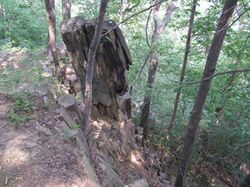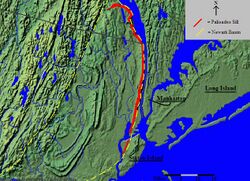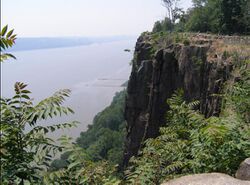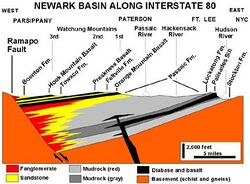Earth:Palisades Sill
The Palisades Sill is a Triassic, 200 Ma diabase intrusion. It extends through portions of New York and New Jersey. It is most noteworthy for The Palisades, the cliffs that rise steeply above the western bank of the Hudson River. The ideal location and accessibility of the sill, as well as its unique features, have generated much attention from nature enthusiasts, rock climbers, and geologists alike.
Location
The outcrop of the Palisades Sill is quite recognizable for its prominent cliffs above the Hudson River; it is easily seen from the western portions of Manhattan. The exposure is approximately 80 kilometers (50 mi) long, most of it following the Hudson River. It first emerges in Staten Island in New York City .[1] The sill then crosses the state line into New Jersey, where Jersey City, Union City, Fort Lee, and Englewood Cliffs all lie on it.
The sill eventually crosses back into New York, following the Hudson River north until reaching Haverstraw. It is at this point that the sill makes a turn to the west, where it disappears near Pomona. At this turn, the sill cuts across local strata, making it a dike in that area, not a sill.
It has been proposed that the sill reemerges in two locations in Pennsylvania (where the outcrops are also discordant with local strata), but this idea is not generally agreed upon, and discussion of the Palisades Sill is usually limited to the exposure in New York and New Jersey.[2]
A portion of the sill is also home to the Palisades Interstate Parkway, a stretch of road that passes through the park area preserved by John D. Rockefeller to protect its natural beauty.
Geology

The end of the Triassic Period saw large-scale rifting during the break-up of Pangaea.[3] What is now eastern North America began to separate from what is now north-western Africa, creating the young Atlantic Ocean. Magma was generated through decompression melting, and a portion of it was intruded into the sandstones and arkoses of the Stockton Formation within the Newark Basin, one of the Eastern North America Rift Basins. The magma would eventually solidify and, after millions of years, the overlying rocks would be uplifted and eroded, exposing the Palisades Sill as we know it today.
The composition of the sill is that of diabase, although its mineral assemblage is not uniform throughout the thickness of the body. The mineralogy of the sill consists principally of plagioclase feldspar, several varieties of pyroxenes, and olivine, with minor biotite, titanite, zircon and oxides.
Most researchers report that, generally speaking, the sill becomes progressively differentiated as one moves away from either the upper or lower contact. The "sandwich horizon" is the term given to the central region where both cooling fronts met; it is here where the diabase is the most differentiated.
The most intriguing geological feature of the sill is a 10-meter-thick olivine-rich zone roughly 10 meters (30 ft) from the lower contact. The modal percent of olivine goes from 0-2% within the main body of the sill to up to 28% within this layer. It is the origin of this layer, and subsequently, the sill as a whole, that has generated much of the attention, as well as the varying origin theories proposed for the intrusion (see below).
There is an average stratigraphic thickness of 300 meters (~1000 feet), with the famous cliffs rising 100 meters (300 ft) on average above sea level. The intrusion dips between 10 and 15 degrees westward for most of its length. It has been determined through stratigraphic studies that the sill was intruded at a depth of approximately 3-5 kilometers. These studies also concluded that the sill was emplaced in a position nearly identical to its current one (10-to-15-degree dip); this is further confirmed by the still-vertical orientation of the columnar jointing.
It has been proposed that the Watchung basalt flows of the Watchung Mountains are extrusive eruptions of the same magma that created the Palisades Sill. Magnetic and gravity measurements have indicated the presence of a large subsurface dike between the Palisades intrusion and the Ladentown basalt, an extrusive body of Watchung basalt north of Suffern, New York.[4] More recently, the various Watchung flows have been correlated to geochemically distinct layers within the Palisades sill, bolstering the theory that eruptions of the Palisades magma were responsible for the episodic flood basalts of the Newark Basin.[5]
Origin

Due to the presence of the olivine-rich zone, the normally difficult task of determining the history of an igneous body becomes even tougher.
- The original studies concluded that the sill was the result of a single injection of magma. The variety in mineralogy was credited to simple crystal fractionation.
- The next model introduced whole rock geochemistry data and determined that there were at least two separate injections; an olivine-rich magma was followed by normal tholeiitic basalt.
- The third hypothesis instead proposed at least three, but probably four separate pulses, with the olivine-rich magma being the final one. This was also conjectured through the use of whole-rock chemistry.
Each of these theories supported the idea of crystal fractionation playing a significant, if not total, role in the differentiation of the sill. A single source for the magma was assumed.
- The latest conclusion reached for the origin of the intrusion was that the olivine in the olivine-rich zone could not have been in equilibrium with the rest of the body, indicating more than one source for the magma. This was determined through mass balance equations. It was also suggested that lateral flow within the still-liquid body played as important a role in differentiation as fractionation.
Due to the interest in the subject, and a lack of a satisfactory conclusion, research on the Palisades Sill is currently ongoing.
See also
Notes
- ↑ "NYC Regional Geology: The Palisades". U.S. Department of the Interior, U.S. Geological Survey. July 22, 2003. http://3dparks.wr.usgs.gov/nyc/parks/loc39.htm. Retrieved 2009-03-29.
- ↑ Husch, J. M., 1990. Palisades sill: Origin of the olivine zone by separate magmatic injection rather than gravity settling. Geology, v. 18, p. 699 – 702.
- ↑ Brannen, Peter (August 16, 2013). "Headstone for an Apocalypse". The New York Times. https://www.nytimes.com/2013/08/17/opinion/headstone-for-an-apocalypse.html?ref=opinion&_r=1&.
- ↑ Kodama, K.P., 1983. Magnetic and gravity evidence for a subsurface connection between the Palisades sill and the Ladentown basalts. Geological Society of America Bulletin, v. 94, no. 1, p. 151-158.
- ↑ Puffer, J.H., Block, K.A., Steiner, J.C., 2009. Transmission of Flood Basalts through a Shallow Crustal Sill and the Correlation of Sill Layers with Extrusive Flows: The Palisades Intrusive System and the Basalts of the Newark Basin, New Jersey, U.S.A. The Journal of Geology, volume 117, p. 139–155.
References
- Gorring, M. L., Naslund, H. R., 1995. Geochemical reversals within the lower 100 m of the Palisades sill, New Jersey. Contributions to Mineralogy and Petrology, v. 119, p. 263 – 276.
- Husch, J. M., 1990. Palisades sill: Origin of the olivine zone by separate magmatic injection rather than gravity settling. Geology, v. 18, p. 699 – 702.
- Lewis, J. V., 1907. The origin and relations of the Newark rocks. New Jersey Geological Survey Annual Report, 1906, p. 99 – 129.
- Lewis, J. V., 1908a. Petrography of the Newark Igneous Rocks. New Jersey Geological Survey Annual Report, 1907, p. 99 – 167.
- Lewis, J. V., 1908b. The Palisade diabase of New Jersey. American Journal of Science, 4th ser., v. 26, p. 155 – 162.
- Shirley, D. N., 1987. Differentiation and Compaction of the Palisades Sill, New Jersey. Journal of Petrology, v. 28, part 5, p. 835 – 865.
- Steiner, J. C., et al., 1992. A cumulus-transport-deposition model for the differentiation of the Palisades sill. "Geological Society of America Special Paper 268", p. 193-217.
- Walker, F., 1940. The differentiation of the Palisade diabase, New Jersey. Geological Society of American Bulletin, v. 51, p. 1059 – 1106.
- Walker, F., 1952. Late magmatic ores and the Palisade sheet. Economic Geology, V. 47, p. 349 – 351.
- Walker, F., 1956. The magmatic properties and differentiation of dolerite sills – A critical discussion. American Journal of Science, v. 254, p. 433 – 443.
- Walker, K. R., 1969a. The Palisades Sill, New Jersey: A Reinvestigation. Geological Society of America Special Paper 111, 178 p.
- Walker, K. R., 1969b. A Mineralogical, Petrological, and Geochemical Investigation of the Palisades Sill, New Jersey. Geological Society of America Memoir, v. 115, p. 175 – 187.
 |





